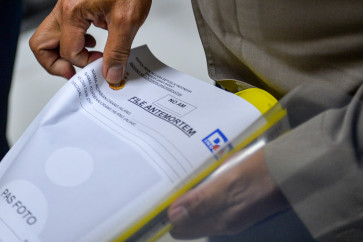'Zaman Edan Kesurupan': Surviving the ages
Petani (Farmer)
Change text size
Gift Premium Articles
to Anyone

Petani (Farmer).
'Come what may an artist will survive. I will not be destroyed by anything,' prominent painter Djoko Pekik said of his decades of work.
The 75-year-old has gone through a long and hard journey.
His experience has molded his art philosophy: his adherence to self-established art principles, his choice and interpretation of art subjects and his metaphorical way of presenting his view on social-cultural events.
Pekik is displaying his works in an exhibition titled 'Zaman Edan Kesurupan' (The Age of Madness, Possession) at the National Gallery in Jakarta until Oct. 20.
Twenty nine paintings and three sculptures particularly exemplify his work from the 1960s through the past decade: two made in the 60's, four in the 80's, three from the 90's and the rest from the past 13 years.
The focal point of the exhibition is a painting titled Pawang Kesurupan (The Possessed Tamers), which was completed in 2012.
The oil painting, measuring 1.5 meters by 2 meters, depicts a Jathilan (bamboo horse) performance, a Javanese traditional dance.
The dance is known for its participants going into a trance and chewing gut-wrenching objects like glass shards and steel nails. An important figure in the dance is the pawang (Tamer), an elder or a leader who brings participants out of their trance and heals their injuries.

In the painting, the dance is performed in front of a panel of judges, but the tamer has also been induced in a trance and is putting embers on his mouth. The judges have gone mad too ' one of them is ready to eat a house gecko, while another already has a live chicken in his mouth.
'The tamers, teachers and elders are supposed to cure people from madness. But if the tamers are possessed too, then how do we heal? We are supposed to follow and believe in our leaders, but they are possessed too,' Pekik said of the painting.
Pekik was born in Grobogan, Central Java, in 1938. He studied art in the late 1950s in Yogyakarta and become a member of Bumi Tarung Studio. The studio was later accused of being affiliated with the defunct Indonesian Communist Party (PKI) and its cultural arm Lekra.
Many of the original member artists of Bumi Tarung died in the aftermath of the aborted September 1965 coup and a state-sponsored attempt to eradicate communism from the country.
Pekik was imprisoned without trial from 1966 in Yogyakarta. In 1972, he was released with the stigma of a political outcast, shunned by fellow artists and relatives during the following decades.
M Dwi Marianto in his curatorial notes of the exhibition said that Pekik's works presented a plethora of subjects taken from social phenomena that he had witnessed or observed through the media.
'From the many phenomena, he would pick one that disturbed him the most. He would focus on that and work his senses on it until he found the heart of the matter,' Marianto said.
The core issue would then turn into a painting; the reflection process might take months, he said.
'Pekik considers the focal point to be the most important aspect in his paintings because he is delivering his own thoughts or deep feelings about an issue,' Marianto said.
Pekik often put representation of himself onto the canvas as a way of stating that he was there ' involved, sensing or affected by the situation he was depicting.
The painter visualizes attitudes, comments and memories about a unique situation from the point of view that was disturbing his thoughts.
Marianto said the 'Zaman Edan Kesurupan' was an exhibition that was significant beyond Pekik's esthetic and artistic horizon.
'He is among the few PKI-connected artists that survived the 1965 purge. This exhibition can be seen as part of national reconciliation movement of the tragedy; this is a movement through art.'








' Photos courtesy of Galeri Nasional Indonesia









